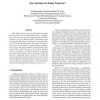Free Online Productivity Tools
i2Speak
i2Symbol
i2OCR
iTex2Img
iWeb2Print
iWeb2Shot
i2Type
iPdf2Split
iPdf2Merge
i2Bopomofo
i2Arabic
i2Style
i2Image
i2PDF
iLatex2Rtf
Sci2ools
FTCS
1998
1998
How Fail-Stop are Faulty Programs?
Most fault-tolerant systems are designed to stop faulty programs before they write permanent data or communicate with other processes. This property (halt-on-failure) forms the core of the fail-stop model. Unfortunately, little experimental data exists on whether or not program failures follow the fail-stop model. This paper describes a tool, based on the SimOS complete-machine simulator, that can trace how faults propagate through memory, disk, and functions. Using this tool on the Postgres database system, we conduct a controlled experiment to measure how often faulty programs violate the fail-stop model. We find that a significant number of faults (7%) violate the fail-stop model by writing incorrect data to stable storage before halting. We then apply Postgres' transaction mechanism to undo recent changes before a crash and find that transactions reduce fail-stop violations by a factor of 3.
Related Content
| Added | 01 Nov 2010 |
| Updated | 01 Nov 2010 |
| Type | Conference |
| Year | 1998 |
| Where | FTCS |
| Authors | Subhachandra Chandra, Peter M. Chen |
Comments (0)

